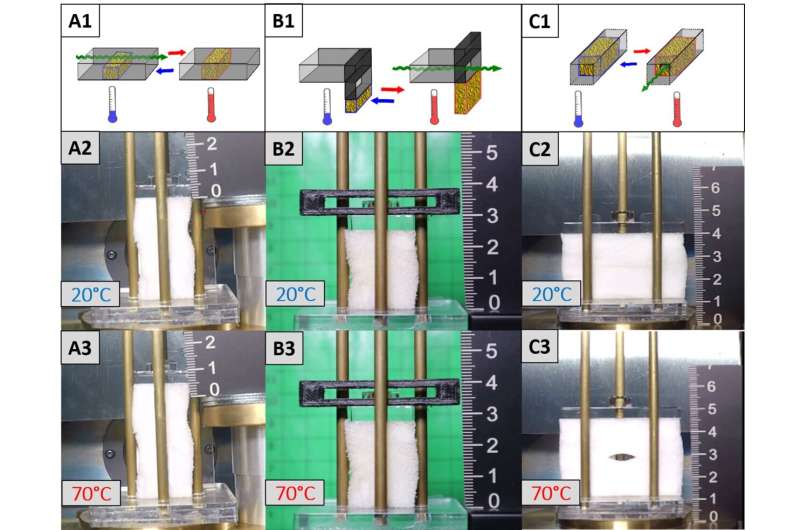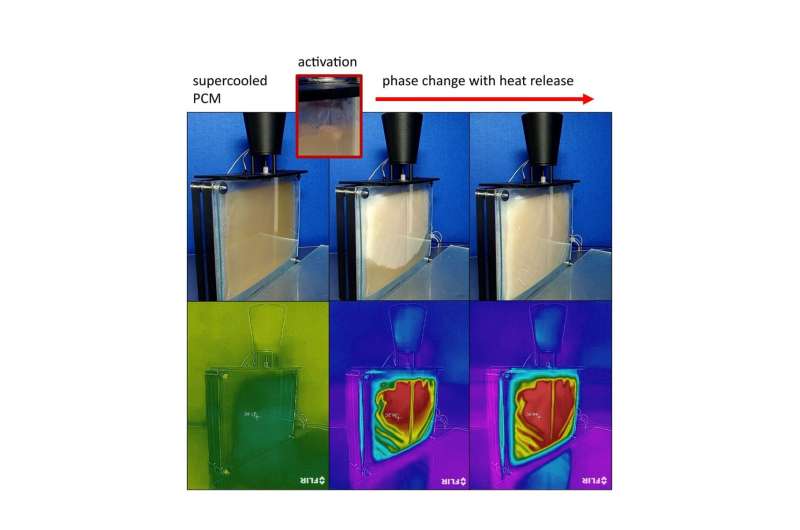
Energy is scarce—and like all scarce things, it comes at a price. That is why Germany needs to greatly reduce its energy consumption. There is significant potential for this in the area of heating and cooling energy which accounts for a large proportion of Germany’s energy consumption. Innovative materials that can be programmed to control heat transition can be a valuable tool in this scenario. The use of materials like these could, for instance, save up to 40% of the energy used to cool single-family homes.
As electricity prices continue to soar, saving electricity is the order of the day. But where can energy be saved? One possibility lies in cooling—on muggy days, many people resort to air conditioning systems to stay cool within their own four walls. But these devices devour a lot of energy, thereby contributing to CO2 emissions and further intensifying climate change. So are we dealing with an endless vicious cycle?
Saving 40% on cooling energy
Researchers from the Fraunhofer Cluster of Excellence Programmable Materials CPM are now on a mission to break this cycle by focusing on programmable home insulation that could replace air conditioning systems in the future. “There is huge potential here: Up to 40% of the cooling energy can be saved in this way,” explains Dr. Susanne Lehmann-Brauns, whose research group is working on this and other developments at Fraunhofer CPM.
The principle behind the research is that, when the sun is beating down and it is very hot, foam elements will expand, thereby sealing the ventilation slots between the building wall and rainscreen cladding to prevent the building from heating up. At night, the foam contracts and opens the ventilation slots, allowing fresh air to circulate behind the cladding and cool the house effectively.
“The outer shell of the house is therefore able to detect temperatures and react accordingly,” says Dr. Lehmann-Brauns. But how does it all work? The programmable insulation is based on a foam that changes shape depending on the temperature: At high temperatures, for example, its pores will open (see Fig. 1). The manufacturing process is used to adjust how the foam changes shape and at what temperature. Here’s what makes it so special: The process is reversible—the foam is able to open and close its pores over and over again. In contrast, conventional shape-memory foams are only able to change their shape once.

A clever combination of three building blocks
What’s more, programmable materials can also be beneficial for thermal management in other ways as well. When it comes to difficult issues in particular, the researchers respond by combining three basic building blocks.
The first building block is the aforementioned programmable insulation. The second building block involves the transport of large amounts of heat. Technical devices such as fuel cells emit a great deal of heat. If this heat rises above the operating temperature, it must be dissipated—and in much larger quantities than can be dissipated using foam with switchable ventilation holes.
Although heat pipes are able to transport large quantities of heat (see Fig. 2), they transport these quantities under virtually all possible conditions, drawing heat from the fuel cell or other technical systems even when this is not desired. Heat pipes are pipes filled with water that are heated at one end, causing the water to evaporate and then condense at the other end of the pipe. In some cases, the effective thermal conductivity of heat pipes is several orders of magnitude higher than copper.
“Our materials adsorb the water and only release it at a set temperature in the heat pipe. This means that below this temperature, the heat pipe is switched off. Above this temperature, there is sufficient water for operation which can transport huge amounts of heat,” explains Christian Teicht, deputy spokesperson for the research group. The researchers have already applied for a patent on this innovation.

The third building block involves programmable heat storage. After all, heat generally accumulates at times and in places where it is not needed. It can be stored in a supercoolable phase change material and then released again in a targeted manner. These materials will be familiar from applications such as gel-heat pads, which are activated by kinking an integrated chip. However, there are only a few supercoolable materials like these available thus far, which means that there are only a few different phase change temperatures.
“We are therefore in the process of developing other materials that can be supercooled well below their melting temperature and activated in a very targeted manner to release their heat (see Fig. 3),” describes Christian Teicht.
One example of such use concerns batteries that are exposed to natural temperature fluctuations, for example in electric cars. Excess heat generated during charging and operation of the battery can be stored in the switchable materials which means that the battery is effectively protected from overheating. What’s more, the heat can be stored for virtually any period of time without loss because the programmable material can be cooled to ambient temperature when it is charged. The heat can be released again if required—for example, when cold starting the battery by activating the material in a targeted manner.
Citation: Programmable home insulation that could replace air conditioning systems (2022, December 1) retrieved 1 December 2022 from https://techxplore.com/news/2022-12-programmable-home-insulation-air-conditioning.html
This document is subject to copyright. Apart from any fair dealing for the purpose of private study or research, no part may be reproduced without the written permission. The content is provided for information purposes only.

